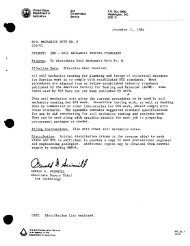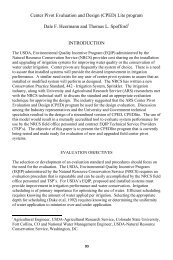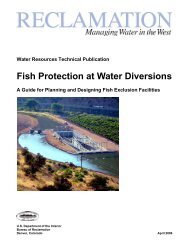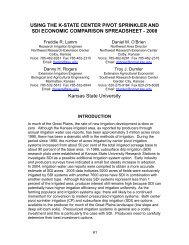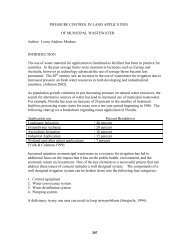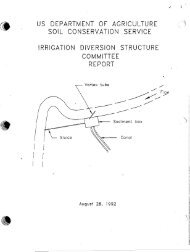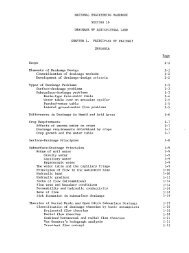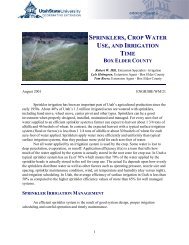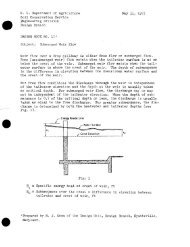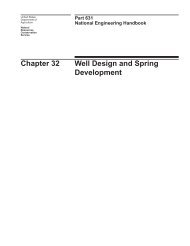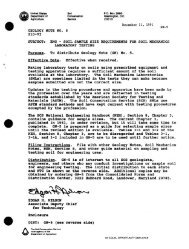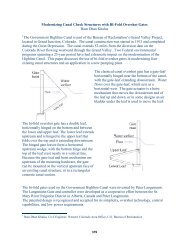Chapter 11: Sprinkle Irrigation - NRCS Irrigation ToolBox Home Page
Chapter 11: Sprinkle Irrigation - NRCS Irrigation ToolBox Home Page
Chapter 11: Sprinkle Irrigation - NRCS Irrigation ToolBox Home Page
You also want an ePaper? Increase the reach of your titles
YUMPU automatically turns print PDFs into web optimized ePapers that Google loves.
The desired I depends on time per set, net depth to<br />
be applied per irrigation, and application efficiency.<br />
It is practical to change periodic-move laterals only<br />
once or twice per day unless they are automated.<br />
For one change per day, the time per set will be 24<br />
hr minus the length of time required to change the<br />
lateral position. leaving a total of 23 to 23.5 hr. For<br />
two changes per day, set times will range between<br />
<strong>11</strong> and <strong>11</strong>.5 hr.<br />
Figure <strong>11</strong>-28 shows a copy of figure <strong>11</strong>-13 completed<br />
for a sample field of alfalfa and potatoes.<br />
Sample calculations <strong>11</strong>-3 and <strong>11</strong>-4 illustrate the<br />
procedure for determining the desired application<br />
rate (I) and related average sprinkle discharge (q)<br />
for the alfalfa field and the potato field, respectively.<br />
Sample calculation <strong>11</strong>-3.-Determine the net depth<br />
per irrigation, irrigation interval, irrigation efficiency,<br />
application rate, and sprinkler discharge requirement.<br />
Given:<br />
The information in parts I and I1 of figure <strong>11</strong>-28<br />
for alfalfa<br />
. - - " -<br />
An average wind of 4-10 mph<br />
Assume:<br />
The soil moisture depletion is MAD = 50%<br />
There will be one change per day<br />
The sprinkler spacing is 40 X 60 ft<br />
Calculation:<br />
For a MAD = 50%" the allowable soil water depletion<br />
is 50 percent of the total available waterholding<br />
capacity of the root zone which in this case<br />
is:<br />
5 U<br />
6 ft X 2.0 inlft X - = 6.0 in<br />
100<br />
The maximum allowable irrigation interval during<br />
the peak use period is<br />
allowable depletion (in) 3-- - 20 days<br />
water use rate (inlday) 0.30<br />
-- " - - - .<br />
These are the maximum allowable depletion and<br />
corresponding maximum interval during the peak<br />
use period that will give the desired level of productivity.<br />
To fit the final system design, lesser net applications<br />
and correspondingly shorter intervals<br />
may be used.<br />
The application efficiency can be estimated from<br />
the effective portion of the applied rate (R,) and the<br />
uniformity of application. Assuming the spray will<br />
be midway between coarse and fine (from fig.<br />
<strong>11</strong>-18) for a potential evapotranspiration rate of 0.3<br />
(0.97 + 0.91) _<br />
inlday the effective portion, Re = -<br />
0.94.<br />
Because alfalfa is a relatively low value crop, an<br />
applied efficiency (Eh) based on the average low-half<br />
depth is appropriate, i.e., use CU. Assuming an Eh<br />
of 75 percent, the gross application would be:<br />
Assuming it will take 1 hour to change the position<br />
of a hand-move lateral, the time per set with<br />
one change per day will be 23 hr. Thus the preliminary<br />
application rate is:<br />
From table <strong>11</strong>-10 (4-10 mph winds) the anticipated<br />
CU = 84% on a 40- x 60-ft spacing and 0.34<br />
iph. A more specific estimate of CU can often be obtained<br />
directly from a supplier, The expected application<br />
efficiency can now be estimated by equation<br />
8:<br />
The required gross application can now be more accurately<br />
computed as:<br />
atld the required application rate is:<br />
I=-- 7'6 in - 0.33 iph<br />
23 hr<br />
The required sprinkler discharge can now be calcw<br />
lated by equation 2:<br />
2



